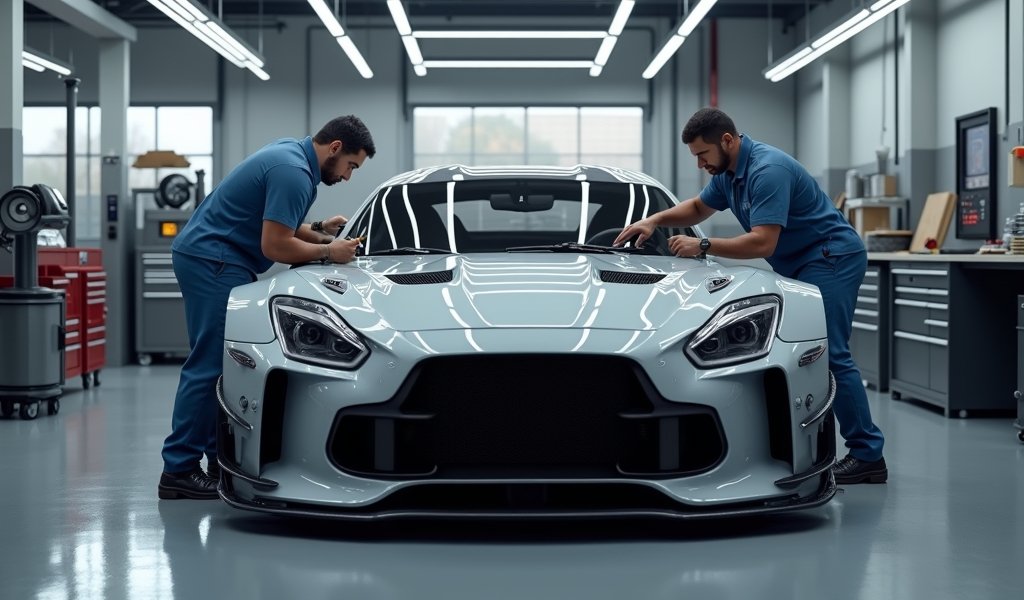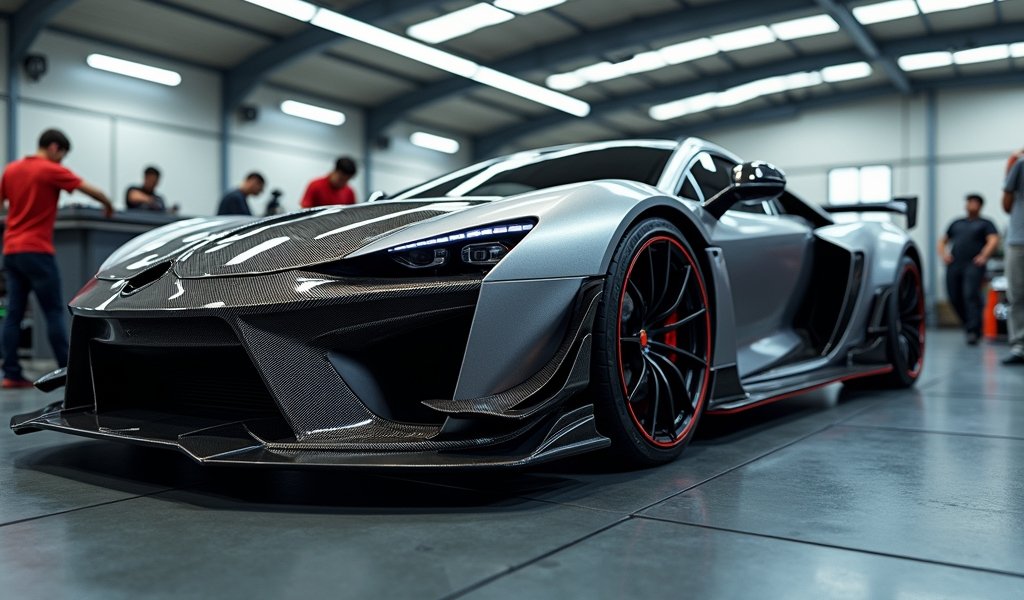Overview
This article provides five essential tips for successfully installing automotive widebody kits: choosing the right kit for your vehicle, gathering necessary tools, properly preparing the vehicle, following a systematic installation process, and applying finishing touches with long-term maintenance in mind. The guide emphasizes that professional-looking results come from meticulous preparation, patience during installation, and attention to detail rather than budget or experience level.
Table of Contents
- What Are Widebody Kits?
- Tip 1: Choosing the Right Kit for Your Vehicle
- Tip 2: Gather All Necessary Tools and Equipment
- Tip 3: Proper Vehicle Preparation
- Tip 4: Follow a Systematic Installation Process
- Tip 5: Finishing Touches and Long-Term Maintenance
- Conclusion
- Frequently Asked Questions
What Are Widebody Kits?
Widebody kits transform ordinary vehicles into eye-catching street machines with aggressive stances and enhanced performance capabilities. As a mechanic who’s installed dozens of these kits over 15 years, I can tell you they’re much more than just aesthetic upgrades.
These aftermarket modifications extend your vehicle’s fenders and overall width, creating that muscular appearance that turns heads at every stoplight. But there’s function behind that form – the additional width typically accommodates wider tires, potentially improving your vehicle’s handling, grip, and overall performance.
Installing a widebody kit is a significant undertaking that demands careful planning and precision. It’s not something you want to rush into on a whim. Think of it as automotive surgery – get it right, and your car becomes something special; cut corners, and you could end up with an expensive mess.
Whether you’re looking to give your sports car that race-inspired look or simply want to create something unique, this guide will walk you through the five essential tips that separate successful installations from regrettable mistakes. I’ve seen both outcomes in my shop, and the difference almost always comes down to preparation and patience.
Tip 1: Choosing the Right Kit for Your Vehicle
The foundation of any successful widebody transformation starts with selecting the appropriate kit. In my years at the shop, I’ve seen countless enthusiasts make costly mistakes by rushing this crucial first step.
Always prioritize vehicle-specific kits designed precisely for your make, model, and year. Those universal “one-size-fits-all” options might tempt you with lower prices, but they typically require extensive modifications and rarely deliver that factory-finished look you’re after. Vehicle-specific kits are engineered to follow your car’s body lines and mounting points, making installation significantly smoother.
When it comes to materials, you have several options, each with distinct advantages:
- Fiberglass: Lightweight and reasonably priced, though potentially brittle without proper reinforcement. Good for skilled DIYers on a budget.
- ABS Plastic: My recommendation for most enthusiasts – offers excellent durability with some flexibility that makes installation more forgiving.
- Carbon Fiber: The premium choice – extremely lightweight and incredibly strong, but priced accordingly. Best reserved for show cars or where weight reduction is crucial.
Your budget will inevitably influence your decision, but I’ve seen $2,000 kits that fit better than $5,000 ones. Research is your best tool here. Before purchasing, spend time on automotive modification forums and social media groups where fellow enthusiasts share unfiltered experiences. Pay close attention to comments about fitment quality and customer support.
Remember that a properly fitting mid-range kit will always look better than a poorly engineered premium option. I’ve installed countless car body kits over the years, and fitment quality consistently trumps brand name or material when it comes to final appearance.

Tip 2: Gather All Necessary Tools and Equipment
Nothing kills momentum faster than realizing you’re missing a critical tool halfway through your installation. Trust me, I’ve been there – and making that hardware store run with your car partially disassembled isn’t fun for anyone.
Before starting, ensure you have these essentials ready:
Basic Tools:
- Quality jack and jack stands for safe vehicle elevation
- Complete socket and wrench sets (both metric and standard)
- Drill with various bit sizes
- Rivet gun and appropriate rivets
- Body filler and application tools
- Cutting tools (air saw, jigsaw, or rotary tool)
- Sandpaper in various grits (80-320)
- Digital caliper or quality measuring tape
- Straight edge and angle finder
- Clamps in various sizes
- Panel adhesive or epoxy
Safety Equipment (Non-Negotiable):
- Safety glasses and face shield
- Respiratory protection (especially when cutting fiberglass)
- Work gloves
- Long-sleeved clothing
- Fire extinguisher
Your workspace matters tremendously. You’ll need good lighting (I recommend supplemental work lights even in well-lit garages), proper ventilation, and enough space to move freely around your vehicle. A concrete floor is ideal – working on dirt or gravel is an exercise in frustration.
Organization saves time and prevents mistakes. Set up a dedicated table for smaller components and use magnetic trays to keep track of hardware. Label everything you remove. Taking photos throughout disassembly might seem excessive, but they’ll become invaluable references during reassembly.
In my experience, having a friend help with test fitting and holding panels saves significant time. Some pieces are simply too large to position accurately by yourself, especially when working with heavier fiberglass components.
Tip 3: Proper Vehicle Preparation
Preparation is where professionals and amateurs truly diverge. A thorough prep phase often takes longer than the actual installation, but it’s what separates showroom-quality results from regrettable outcomes.
Start with a deep cleaning of all areas where widebody components will attach. Use automotive degreaser for stubborn residue and finish with isopropyl alcohol to ensure perfect adhesion. Even invisible contaminants can prevent proper bonding, leading to future failures.
Most widebody installations require removing factory components like fender liners, bumper attachments, or trim pieces. Document everything you remove with photos and keep hardware organized in labeled containers. Future you will appreciate this level of organization when reassembly time arrives.
Before making any irreversible modifications to your vehicle, take precise measurements and create clear guidelines. I typically use painter’s tape to mark cutting lines – it provides a visual guide that’s easy to follow and doesn’t damage paint if you need to reposition it. When in doubt, cut less than you think necessary – you can always remove more material, but you can’t put it back.
The test fitting phase is absolutely critical. Temporarily position each component without permanent attachment to verify alignment and identify any interference points. This dry run often reveals necessary adjustments before permanent installation begins. I’ve seen countless rushed installations that required expensive rework because the installer skipped proper test fitting.
If your kit requires connecting to existing mounting points, verify their integrity before proceeding. Rusted or damaged mounting areas should be repaired before installation to ensure proper support for your new components. This is especially important for heavier fiberglass or metal widebody parts.
Consider using custom wheels and tires that complement your new widebody stance. The right wheel fitment can make or break the overall appearance of your widebody build.
Tip 4: Follow a Systematic Installation Process
Installing a widebody kit is a methodical process that rewards patience and punishes rushing. Working systematically ensures consistent quality throughout the installation.
I always recommend beginning with either the front or rear fenders before moving to side skirts and bumpers. This approach helps you develop techniques that improve as you progress. Start with the simplest components to build confidence before tackling the more challenging sections.
When securing components, maintain consistent spacing and alignment. Use clamps to hold pieces in position while marking mounting points. For the cleanest look, place hardware in inconspicuous locations whenever possible. Nothing ruins a beautiful widebody installation faster than visible fasteners in awkward positions.
Pay special attention to panel gaps. Consistent spacing between components creates that factory-finished appearance we’re all after. I typically aim for 5-8mm gaps between panels, similar to OEM specifications. Inconsistent gaps immediately signal amateur installation to the trained eye.
Common installation mistakes I frequently see include:
- Rushing through test fits (measure twice, cut once)
- Over-tightening fasteners (which can crack components)
- Insufficient edge sealing (leading to moisture intrusion)
- Misaligned panels (resulting in uneven gaps)
- Inadequate reinforcement of cut areas
Know when to seek help. If you encounter aspects beyond your skill level—such as extensive cutting of structural components or complex electrical modifications for widened lighting elements—consider consulting a professional. The cost of expert help for challenging sections often saves money compared to repairing mistakes.
When you inevitably encounter fitment issues, take a step back before making drastic modifications. Sometimes slight adjustments to mounting points can resolve alignment problems without permanent alterations to the components themselves.

Tip 5: Finishing Touches and Long-Term Maintenance
The difference between a good widebody installation and a great one often lies in the finishing details. After the physical installation, several critical steps remain to complete your transformation properly.
Most kits arrive unpainted, requiring professional color matching to your vehicle. Allow sufficient curing time (typically 24-48 hours) for all adhesives and fillers before painting to prevent future complications. If budget allows, consider protective clear coats for added durability, especially for lower components exposed to road debris.
Proper sealing is non-negotiable for long-term durability. Waterproof all seams and joints using automotive-grade silicone or seam sealer. Pay special attention to areas around wheel wells and lower edges where moisture might infiltrate. This preventive measure guards against rust formation and water intrusion that can damage your vehicle’s interior.
After completion, perform a thorough inspection while driving at various speeds. Listen for unusual wind noise that might indicate poor sealing, and watch for vibration that could suggest loose components. Most issues are easier to address immediately rather than after they’ve worsened.
Different materials demand different maintenance approaches:
- Fiberglass requires periodic inspection for cracks or chips
- ABS plastic benefits from UV protectant to prevent fading
- Carbon fiber should be treated with specialized cleaners to maintain its finish
Regular cleaning under fender flares and behind add-on components prevents dirt and debris accumulation that could lead to paint damage or corrosion. A soft bristle brush helps reach these tight areas without scratching surfaces.
Consider enhancing your widebody build with complementary modifications like custom exhaust systems that provide both performance benefits and aesthetic appeal. The right exhaust can perfectly accentuate your car’s aggressive new look.
During seasonal changes, check all mounting points for security, as temperature fluctuations can affect adhesives and cause hardware to loosen. This simple preventive maintenance prevents more serious issues down the road.
Conclusion
Transforming your vehicle with a widebody kit represents both a significant investment and an opportunity to create something truly unique. The process demands patience, precision, and proper planning, but the results can be absolutely stunning when done correctly.
By following these five essential tips—selecting the right kit, gathering proper tools, preparing thoroughly, following a systematic process, and focusing on finishing details—you’ll maximize your chances of achieving professional-quality results that turn heads for all the right reasons.
Remember that what separates exceptional widebody builds from disappointing ones isn’t necessarily budget or experience, but rather the willingness to slow down, research thoroughly, and execute methodically. The extra time spent in preparation and careful installation will be evident in your final result.
Whether tackling this project yourself or seeking professional assistance, these fundamentals remain the foundation of a successful widebody transformation. With proper attention to detail and the right approach, your widebody build can deliver years of satisfaction and admiring glances.
Frequently Asked Questions
How much does a professional widebody kit installation typically cost?
Professional installation usually ranges from $2,000 to $5,000, not including paint. This varies based on kit complexity, vehicle type, and the amount of custom work required.
Can I install a widebody kit without cutting my original fenders?
Some “bolt-on” kits allow installation without cutting, but most quality widebody kits require fender modification. Bolt-on solutions often look less integrated and may affect performance.
Will installing a widebody kit affect my car’s warranty?
Yes, widebody modifications typically void manufacturer warranties related to body structure and potentially drivetrain. Check with your dealer about specific warranty implications before proceeding.
How long does a typical widebody kit installation take?
A professional installation typically requires 1-2 weeks including preparation and paint. DIY installations often take 2-4 weeks of weekend work, depending on experience level.
Do I need to register my car as modified after installing a widebody kit?
Registration requirements vary by location, but significant width increases may require inspection or registration updates. Check your local transportation authority guidelines before significantly altering your vehicle’s dimensions.

